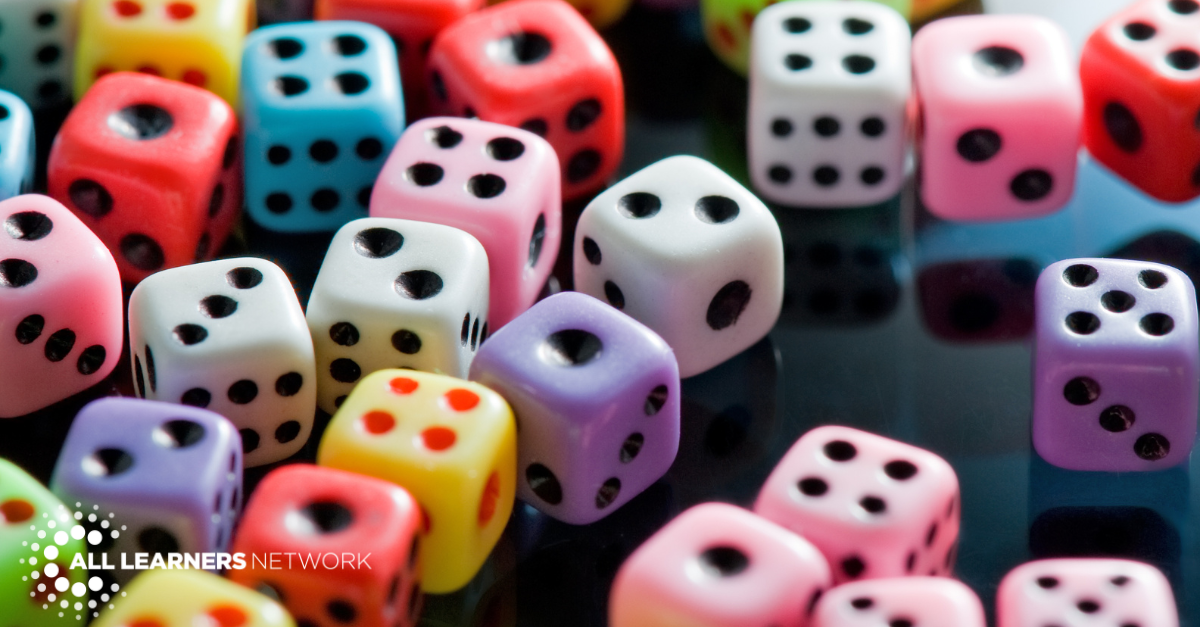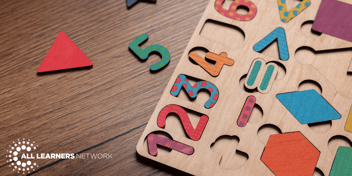
Three Dice “Games” to Build Number Sense During Transitions
Published: June 21, 2024
A collection of dice is an invitation. Pick them up and listen to the sound they make as they tumble around in your hands. Use two hands or one to shake them up and let them fly. The anticipation of what they might reveal as they roll and settle is a thrill. Did we get what we were looking for or do we need to roll again? What do we notice about the dots or numbers on the dice? Do you see what I see?

Dice games provided ample and varied opportunities for my kindergarteners to build number sense. Each roll offered a reason to subitize, count, compose, decompose, and recompose numbers. Each roll of the dice was a chance to discuss what they saw. They shared and compared strategies for figuring out how many.
Dice of all shapes and sizes were everywhere in my classroom. Sure, they were in use when we played games, but the time I valued dice most was during transitions or what we called “the being patient times” in my kindergarten class. It can be hard to wait and we do not all finish at the same time. Dice were the solution to those short moments in a school day when there was not enough time to start something new, but it was also not really time to clean up either.
Admittedly these may not be games in the truest sense of the word “game”. These games are also not just for kindergarten. I have used these games (or variations) with learners in grades Kindergarten through 6 to make the waiting times more fun and rich with number play and number conversations.
Roll and Go
This is a movement activity. Write the numbers you want your learners to tangle with on sticky notes or large pieces of paper and place them around the room. The numbers could be placed in sequence or in random order. The children then roll their die( or dice) and move to the number they rolled. For example, if they ”roll” a 6 they would look for the numeral six and “go” to the six. Sometimes the cards we hung around the classroom showed expressions instead of numerals. If they rolled a five they might go 2+3 or 4+1. A variation of roll and go we loved was “roll, go, and chat” or “roll, go, and move”. In these instances there was something to talk about at each number( e.g. a problem to solve or picture to discuss) or movement to do (e.g. crab walk or jumping jacks). Play continues with children rolling and going until the waiting time is over and everyone is ready for what comes next. As with any movement activity, it was important for us to have clear class guidelines for how we were going to “roll and go.” Once our routine was established (and practiced) it was a class favorite that we could use in an instant when patience was required.
Going to Boston
This game may be familiar, but each time I play this game with children or adults we seem to come up with another variation. Each player has 3 dice. Players roll all three dice and set aside the die with the greatest value. Players roll the remaining two dice and again set aside the die with the greatest value. Players roll the last die and add up the total of all three dice. That’s it.
Going to Boston Variations: Roll 4 or 5 dice, instead of adding up the total, multiply! Focus on place value by having learners build the greatest number or smallest 3-digit number, comparing numbers, graphing (bar graph, line plot), rounding, magnitude-place the number made on a number path or number line.
What’s in the Cup
A wonderful colleague taught me this game and I have had it in constant rotation ever since. What’s in the Cup can be played with the whole group, a small group, and even while waiting in the hallway for the lunch line to move. All you need is a cup and two dice, to start. Make sure the group knows what kind of dice and how many dice are in the cup. Give the cup a shake and tell the group the value of the sum in the cup. Learners take turns guessing the addends in the cup. Sometimes you might want them to guess all the possible addends and then reveal what’s actually in the cup, and other times you’ll just keep the game moving with new sums once a guess has been made.
We loved dice in my classroom and many of the games I still use today were invented through the open-ended exploration and play that dice promote. Every year we discussed and wrote dice “rules” that would support the fun and the independence. We revisited our list regularly to edit and revise our rules. The message was to have fun, notice the numbers, and take care of each other and our tools. For some of my learners, the sound of their dice rolling on a hard surface was not a welcome addition to an already stimulating classroom environment. Rolling dice on the carpet or piece of felt helped limit the extra sounds. Some learners benefited from having a basket or small bin to roll their dice into. Repurposed large and small yogurt cups are wonderful dice shakers and catchers.
Are those dice on the shelf or in the closet inviting you to play and tinker with numbers? I hope so. Have fun!
Click here for the printable version.
What Now?
1. Join All Learners Online (ALO) to get access to more games to use in your math block!
2. Check out our blog on Playing with Numbers: Early & Joyful Math Interactions.
3. Bring All Learners Network (ALN) into your school or district for embedded professional development.

All Learners Network is committed to a new type of math instruction. We focus on supporting pedagogy so that all students can access quality math instruction. We do this through our online platform, free resources, events, and embedded professional development. Learn more about how we work with schools and districts here.




